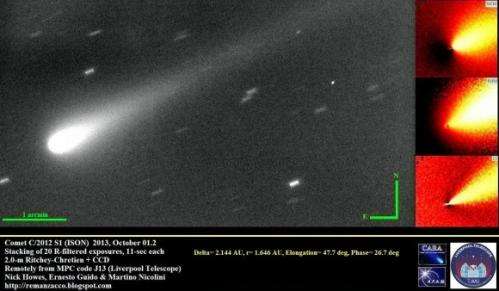Is comet ISON disintegrating?

Astronomer Ignacio Ferrin, FACom researcher, analyzed the most recent observational data of Comet ISON and has identified clear signatures of what he has called an "impending demise." The so-called light-curve of the comet shows features previously observed in disintegrating comets.
Since his previous announcement, the predictions of Prof. Ignacio Ferrin concerning the uncertain future of Comet ISON are being if not definitively confirmed at least supported by the most recent optical observations. Despite the generalized skepticism and claims about the fact that the rumors of Comet ISON "fizzling" were greatly exaggerated, the comet is still showing an unexpected behavior that cometary specialists are fighting to explain.
"Comet ISON has presented a peculiar behavior," said Prof. Ferrin while confirming what he already stated in the previous FACom press release. He continues by saying that "the light curve of the comet exhibited a slowdown event characterized by a constant brightness with no indication of a brightness increase tendency." This slowdown began around January 13, 2013, and, according to Prof. Ferrin, it continued up to the latest available observations at the end of September 2013. The brightness has remained practically constant for more than 270 days or 9 months, a behavior without any precedent in cometary astronomy. This evidence has led Prof. Ferrin to conclude that it is probably that the comet is dying.
In a recent letter posted to Cornell University arXiv preprints repository (arxiv.org/abs/1310.0552), Prof. Ferrin presented and discussed what he identified as a peculiar photometric signature previously observed in disintegrating comets. In his own words "when I saw this signature I immediately went to my database of comet light curves, and found that two comets had also presented this signature: Comet C/1996 Q1 Tabur and Comet C/2002 O4 Hönig; to my surprise these two comets had vanished turning off or disintegrating." According to Prof. Ferrin this observation is irrefutable evidence that Comet ISON is following the same path of those defunct comets. The following few weeks will reveal the real fate of weird Comet ISON.
Interestingly a comparison between the light curves of ISON and eight previously disintegrating comets is allowing Prof. Ferrin to predict that the object has already entered into a sort of "danger zone" using his own words. No theoretical model exists capable of explaining all the observed phenomena with those defunct comets.
Several well known facts about the strange behavior of Comet ISON should be widely recognized. It was expected that the comet would bright up after passing the "frost line," a distance at which comets tend to turn on water production. Some astronomers locate this line between 2.5 and 3 AU. But the comet has already passed that line and almost none has occurred. This was the last chance of the comet to exhibit some healthy activity but ISON has surprised experts by maintaining almost unmodified its photometric behavior. Additionally ISON faces other challenges as it approaches to the inner solar system. First, the comet will reach perihelion very near the Sun, where Prof. Ferrin has calculated a temperature of 2,700 degrees Celsius, high enough to melt iron and lead. Second, besides this trial by fire, the comet will penetrate the solar Roche limit. Any object penetrating this forbidden limit will experience solar tides that may tear apart the nucleus of the comet. The combination of temperature, radiation and tides may prove too much for the comet, which may not survive the encounter with the Sun.
More information: astronomia.udea.edu.co/cometspage
Provided by FACOM





















